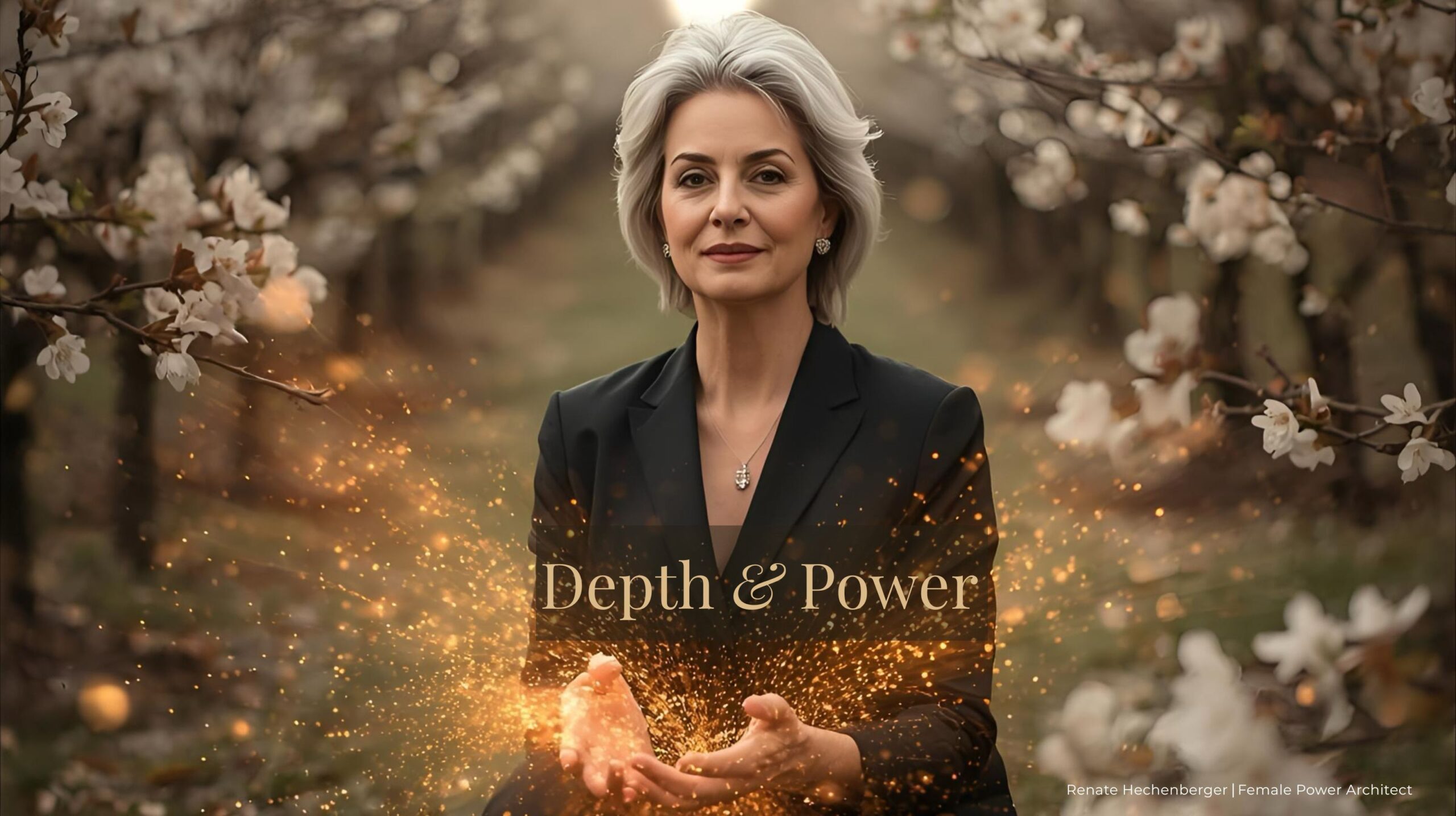When Stillness Becomes the Teacher
There comes a moment in every Deep Cycle when answers stop serving. The questions grow quieter, but not smaller. They begin to move inside the body instead of the mind.
For Hedwig, that moment arrived on the morning of her company’s annual leadership retreat. The air smelled of pine and rain. She stood before a room of senior managers, all waiting for her to open the session. Normally she would have begun with a crisp vision statement and the next quarter’s goals. But this time, the words would not come.
Something in her body whispered: Not everything needs an answer. But everything needs your presence.
She looked around the room—faces expectant, pens ready—and simply said, “Let’s take a breath together.”
Silence. Confusion. Then, slowly, the rhythm of breathing spread through the room. Shoulders lowered. The noise softened. And something deeper began to listen.
That was how the retreat began—not with performance, but with presence.
What followed surprised her. The planned strategy session unfolded with unexpected honesty. Someone spoke about burnout. Another confessed that the recent restructuring had left her doubting her place in the company. Instead of steering the discussion back to the agenda, Hedwig let the silence breathe. She noticed how the group relaxed when she did nothing. How trust grew in spaces where control dissolved.
She realized that the team didn’t need more plans. They needed ground. Her ground.
When Depth Replaces Perfection
In the months leading up to that morning, Hedwig had already walked through the great unravelling: cutting old wires, saying the sovereign No, building her Depth Compass. But now she faced another threshold—the shift from clarity to connection.
Her old instinct still tried to polish every message, to perfect every slide, to anticipate every question. But now, perfection felt strangely brittle. It lacked warmth. It disconnected her from what was actually happening.
Depth asked something else of her—not more skill, but more being.
When she stopped preparing the next answer, she started hearing what people truly said between the lines. When she released control, conversations found their own intelligence. What used to feel like leadership became something gentler: attunement.
This was no longer the leadership of control. It was the leadership of resonance. It did not demand outcomes. It invited coherence.
And the more she trusted that rhythm, the more the external world began to mirror it. Conflicts settled faster. Creativity returned. Even her own body felt different—less armored, more alive. The migraines that had haunted her for years were gone.
The Quiet After Achievement
Years ago, I crossed that same threshold.
I had spent three decades in international leadership—boardrooms, launches, deadlines, global moves. Success looked clear on paper. But the higher I climbed, the more the air thinned. At fifty, I realized the life I had built no longer matched the rhythm of my own breath.
The day I stepped out of the corporate world, I expected relief. Instead, I met a silence that frightened me. Without the noise of constant performance, who was I? For months I felt like a radio tuned between stations—static everywhere, no melody.
I tried to fill the void with planning. I studied, consulted, advised. But the deeper truth was that I was afraid to be still. Stillness exposed everything I had covered with doing. The pride, the exhaustion, the longing.
Only much later did I understand: that silence was not emptiness. It was depth inviting me home.
It took time—years, not months—to learn to listen without needing to fix. To sit with discomfort until it revealed meaning. To stop equating speed with value. That passage became the foundation of my later work with women—the place where achievement dissolves and essence begins. Where leadership is not what you do, but what moves through you when you are fully present.
Depth, I learned, is not quiet because it is empty. It is quiet because it is full.
Presence as Power
Hedwig began to sense this too. During one meeting, a younger colleague broke down over a failed project. The old Hedwig would have jumped in—problem-solving, instructing, reassuring. This time she simply stayed. No advice. No correction. Just quiet presence.
Minutes passed. The woman’s breathing steadied. When she finally looked up, her eyes were clear. “Thank you for not fixing me,” she said softly. “I just needed to feel I wasn’t alone.”
That is depth as leadership: not reaction, but resonance. Not solution, but space.
Presence steadies what pressure distorts. It is the field that allows others to find their own rhythm again.
Soon, Hedwig noticed how people began to speak differently around her. Less guarded. Less polished. They didn’t seek her approval anymore; they sought her listening. Something subtle but profound had changed: she was no longer the center of power. She had become its ground.
The Architecture of Depth
Depth is not passive. It is a different kind of architecture—one that holds through stillness.
Imagine the orchard in full summer. The branches no longer rush to grow; they hold. The roots have gone deep enough that storms no longer define them. That is what happens when women lead from presence. The trellis no longer dictates shape. The roots decide.
Depth is the phase of leadership where truth stops performing. Where integrity replaces ambition as the driving force. It is the place from which decisions arise naturally, without inner conflict. You can feel it in the room when a woman speaks from that ground—her tone carries weight, not volume. Her clarity moves others, not because it is perfect, but because it is true.
Depth means decisions no longer arise from fear, urgency, or approval. They grow from coherence—a felt alignment between inner truth and outer action. The body becomes the meeting point of clarity and compassion.
From this place, authority is no longer claimed. It is recognized.
And recognition, when it comes, is no longer the goal. It is simply the echo of authenticity.
The Subtle Temptation to Return
But the path to depth is not linear. Even after months of inner alignment, Hedwig sometimes felt the pull to return to old rhythms. The adrenaline of crisis still tempted her—the satisfying illusion of importance that comes with being indispensable.
Each time, she noticed how her energy constricted when she tried to control. And each time she returned to breath, to presence, to trust.
Depth requires constant remembrance. It is not a final state; it is a living practice.
Practice: Presencing Instead of Proving
This week, when a question or conflict arises, try this simple sequence:
Pause. Stop before you answer. Notice the first wave of thought and emotion.
Feel. Where does your body contract? Where does it open?
Root. Breathe into the space beneath your feet. Remember: ground first, speak later.
Respond. From the place that feels steadier, not louder.Each time you choose presence over performance, you rewire your leadership. You shift from doing power to being power.
Over time, this becomes your natural compass.
Meetings change.
Relationships soften.
And decisions once made from pressure begin to emerge from trust.
This is the real alchemy of depth—it dissolves urgency and replaces it with alignment.
The Orchard in Full Leaf
Weeks after the retreat, Hedwig paused in thought, recalling the orchard she often imagined when her mind needed space — a quiet inner landscape where everything could simply breathe. The trees stood heavy with fruit. The air carried the scent of late summer and soil. She ran her fingers along a low branch, feeling its quiet strength. Nothing hurried. Nothing proved. Everything simply held its place in the rhythm of life.
She thought of the women she had met along the way — the mentor who taught her to listen, the colleague who dared to slow down, the young intern whose courage had sparked her own compassion. The orchard, she realized, had never been just a metaphor. It was the living field of women, seasons, and shared depth.
She realized then: leadership is not about carrying more, but about rooting deeper. The women she led did not need her answers. They needed her presence.
The air was still. Somewhere, laughter drifted—the intern’s voice, perhaps, from the next garden. Hedwig smiled.
Not everything needs an answer, she thought. But everything needs my presence.
And the cycle turned again—from presence to power embodied.
✨ If this resonated with you, I invite you to stay in the Orchard—a field of reflection on women, power, and leadership.
More of this work lives inside my e-book Unapologetic Power - and forms the base of the one-year journey The Deep Cycle: for women who lead from depth.
About the Author
30 years of international leadership responsibility, 15 years empowering women in top positions.
Renate Hechenberger opens spaces where the inner architecture emerges—an architecture that anchors women in their feminine power.
© 2025 Renate Hechenberger. All rights reserved.
Credit: Image created with Canva AI.

